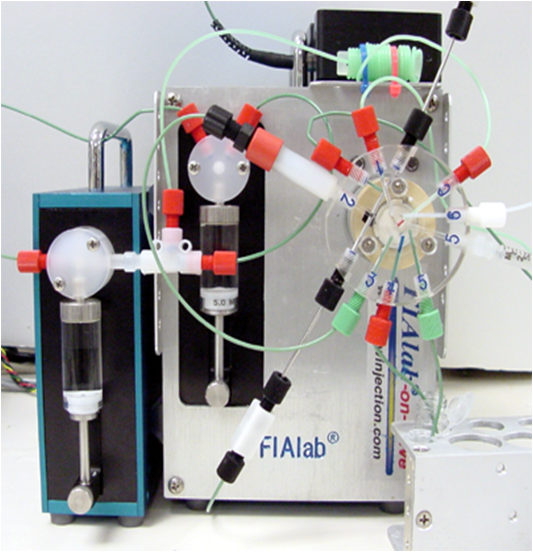Solid phase extraction has almost entirely replaced solvent extraction, since it eliminates use of organic solvents and simplifies automation of the separation step. Unfortunately a majority of sorbent extractions are still carried out manually (Fritz 1999). FI and SI offer a unique opportunity to change this labor intensive and error prone approach. In SE procedure, analytes are extracted from liquid phase onto a surface of a solid phase that is furnished with an appropriate ligand. If the particles, packed in a small column, are hydrophobic (such as surface bound C-18), any non- charged, organic compound can be extracted from aqueous phase. This opens a door for the use of all chelating agents that have been applied for trace analysis of metals by solvent extraction, since metal selective ligands (hydroxyquinoline, cupferrone, dithizone etc.) can be adsorbed on stationary phase, allowing capture of a target metal ion from complex aqueous matrix (Motomizu 2008).
Sorbent Extraction
2.3.21.

Automation of sorbent extraction by Flow Injection or by Sequential Injection (Miró and Hansen 2006) is practical and efficient approach for sample preconcentration and matrix removal. There are yet unexplored research opportunities in combination of microSI- long light path flow cell with SE separation for development of selective assays with much improved limits of detection. Comprehensive reviews of Miró and Hansen and of Motomizu and Sakai are truly valuable for anyone interested in applications of FI/SI SPE.
On-line Sample Pretreatment. S. Motomizu and T. Sakai Chapter 7 in: Advances In Flow Injection Analysis and Related Techniques, S.D.Kolev and I.D. McKelvie Elsevier 2008.
Analytical Solid Phase Extraction. J.S. Fritz Wiley New York 1999.









